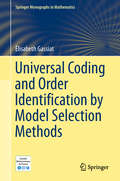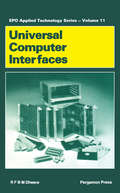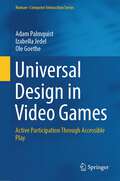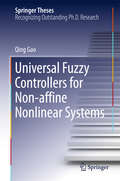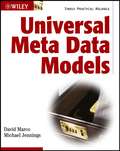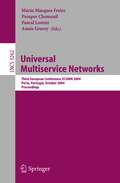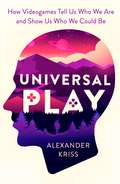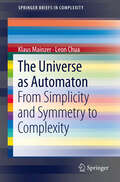- Table View
- List View
Universal Artificial Intelligence: Sequential Decisions Based on Algorithmic Probability (Texts in Theoretical Computer Science. An EATCS Series)
by Marcus HutterPersonal motivation. The dream of creating artificial devices that reach or outperform human inteUigence is an old one. It is also one of the dreams of my youth, which have never left me. What makes this challenge so interesting? A solution would have enormous implications on our society, and there are reasons to believe that the AI problem can be solved in my expected lifetime. So, it's worth sticking to it for a lifetime, even if it takes 30 years or so to reap the benefits. The AI problem. The science of artificial intelligence (AI) may be defined as the construction of intelligent systems and their analysis. A natural definition of a system is anything that has an input and an output stream. Intelligence is more complicated. It can have many faces like creativity, solving prob lems, pattern recognition, classification, learning, induction, deduction, build ing analogies, optimization, surviving in an environment, language processing, and knowledge. A formal definition incorporating every aspect of intelligence, however, seems difficult. Most, if not all known facets of intelligence can be formulated as goal driven or, more precisely, as maximizing some utility func tion. It is, therefore, sufficient to study goal-driven AI; e. g. the (biological) goal of animals and humans is to survive and spread. The goal of AI systems should be to be useful to humans.
Universal Coding and Order Identification by Model Selection Methods (Springer Monographs in Mathematics)
by Élisabeth Gassiat Anna Ben-HamouThe purpose of these notes is to highlight the far-reaching connections between Information Theory and Statistics. Universal coding and adaptive compression are indeed closely related to statistical inference concerning processes and using maximum likelihood or Bayesian methods. The book is divided into four chapters, the first of which introduces readers to lossless coding, provides an intrinsic lower bound on the codeword length in terms of Shannon’s entropy, and presents some coding methods that can achieve this lower bound, provided the source distribution is known. In turn, Chapter 2 addresses universal coding on finite alphabets, and seeks to find coding procedures that can achieve the optimal compression rate, regardless of the source distribution. It also quantifies the speed of convergence of the compression rate to the source entropy rate. These powerful results do not extend to infinite alphabets. In Chapter 3, it is shown that there are no universal codes over the class of stationary ergodic sources over a countable alphabet. This negative result prompts at least two different approaches: the introduction of smaller sub-classes of sources known as envelope classes, over which adaptive coding may be feasible, and the redefinition of the performance criterion by focusing on compressing the message pattern. Finally, Chapter 4 deals with the question of order identification in statistics. This question belongs to the class of model selection problems and arises in various practical situations in which the goal is to identify an integer characterizing the model: the length of dependency for a Markov chain, number of hidden states for a hidden Markov chain, and number of populations for a population mixture. The coding ideas and techniques developed in previous chapters allow us to obtain new results in this area. This book is accessible to anyone with a graduate level in Mathematics, and will appeal to information theoreticians and mathematical statisticians alike. Except for Chapter 4, all proofs are detailed and all tools needed to understand the text are reviewed.
Universal Compression and Retrieval (Mathematics and Its Applications #274)
by R. KrichevskyObjectives Computer and communication practice relies on data compression and dictionary search methods. They lean on a rapidly developing theory. Its exposition from a new viewpoint is the purpose of the book. We start from the very beginning and finish with the latest achievements of the theory, some of them in print for the first time. The book is intended for serving as both a monograph and a self-contained textbook. Information retrieval is the subject of the treatises by D. Knuth (1973) and K. Mehlhorn (1987). Data compression is the subject of source coding. It is a chapter of information theory. Its up-to-date state is presented in the books of Storer (1988), Lynch (1985), T. Bell et al. (1990). The difference between them and the present book is as follows. First. We include information retrieval into source coding instead of discussing it separately. Information-theoretic methods proved to be very effective in information search. Second. For many years the target of the source coding theory was the estimation of the maximal degree of the data compression. This target is practically bit today. The sought degree is now known for most of the sources. We believe that the next target must be the estimation of the price of approaching that degree. So, we are concerned with trade-off between complexity and quality of coding. Third. We pay special attention to universal families that contain a good com pressing map for every source in a set.
Universal Computer Interfaces (ISSN #Volume 11)
by R.F.B.M. DheerePresents a survey of the latest developments in the field of the universal computer interface, resulting from a study of the world patent literature. Illustrating the state of the art today, the book ranges from basic interface structure, through parameters and common characteristics, to the most important industrial bus realizations. Recent technical enhancements are also included, with special emphasis devoted to the universal interface adapter circuit. Comprehensively indexed.
Universal Design: The HUMBLES Method for User-Centred Business
by Francesc Aragall Jordi MontanaAs a customer, have you ever felt dissatisfied with a product or service? Is it possible that customers may be similarly unhappy with your company? Being aware of and exploring your consumers' diversity constitutes the best source of information available if you are to lead the way in design innovation, marketing orientation and service provision. Universal Design: The HUMBLES Method for User-Centred Business offers every type of organization a clear understanding of the role and value of Design for All/Universal Design (the intervention in environments, products and services to enable everyone, regardless of age, gender, capabilities or cultural background, to enjoy them on an equal basis). The seven phase model integrates the users' point of view, enabling you to assess your current business strategy and design practices, and make your product or service appealing to all your potential customers, thus creating a better, more consumer-oriented experience. This book is a must-read for organisations who wish to consider their products and services from the customer point of view and so gain an advantage over their competitors.
Universal Design: The HUMBLES Method for User-Centred Business
by Francesc Aragall Jordi MontanaAs a customer, have you ever felt dissatisfied with a product or service? Is it possible that customers may be similarly unhappy with your company? Being aware of and exploring your consumers' diversity constitutes the best source of information available if you are to lead the way in design innovation, marketing orientation and service provision. Universal Design: The HUMBLES Method for User-Centred Business offers every type of organization a clear understanding of the role and value of Design for All/Universal Design (the intervention in environments, products and services to enable everyone, regardless of age, gender, capabilities or cultural background, to enjoy them on an equal basis). The seven phase model integrates the users' point of view, enabling you to assess your current business strategy and design practices, and make your product or service appealing to all your potential customers, thus creating a better, more consumer-oriented experience. This book is a must-read for organisations who wish to consider their products and services from the customer point of view and so gain an advantage over their competitors.
Universal Design for Learning in the Early Childhood Classroom: Teaching Children of all Languages, Cultures, and Abilities, Birth – 8 Years
by Pamela Brillante Karen NemethUniversal Design for Learning in the Early Childhood Classroom focuses on proactively designing PreK through Grade 3 classroom environments, instruction, and assessments that are flexible enough to ensure that teachers can accommodate the needs of all the students in their classrooms. Typically developing students, gifted students, students who are impacted by poverty, children who speak multiple languages or have a home language that is different than the classroom language, and students with identified or potential developmental or learning disabilities are all covered within this highly practical, easy-to-use guide to UDL in the early years.
Universal Design for Learning in the Early Childhood Classroom: Teaching Children of all Languages, Cultures, and Abilities, Birth – 8 Years
by Pamela Brillante Karen NemethUniversal Design for Learning in the Early Childhood Classroom focuses on proactively designing PreK through Grade 3 classroom environments, instruction, and assessments that are flexible enough to ensure that teachers can accommodate the needs of all the students in their classrooms. Typically developing students, gifted students, students who are impacted by poverty, children who speak multiple languages or have a home language that is different than the classroom language, and students with identified or potential developmental or learning disabilities are all covered within this highly practical, easy-to-use guide to UDL in the early years.
Universal Design in Video Games: Active Participation Through Accessible Play (Human–Computer Interaction Series)
by Adam Palmquist Izabella Jedel Ole GoetheAs participation in game related activities increases around the world and across a larger part of the population, it is obvious that games are not just an entertainment medium for children or young people. Games can be used to accomplish different purposes for different groups of people in society. Developing a universal designed game involves more than adding a cast of diverse characters. Games with universal design, at their core, are experiences that are designed from the ground up to be accessible to everyone – through mechanics, options, and user experience. This book explains the meaning and need for universal design in video games and sheds light on important disciplines. Researchers define a universal designed game as a video game that actively welcomes all players. When players connect authentically with a video game, they’re much more likely to engage with the content. Conversely, when players can’t physically play a game, or don’t see characters that look like them, they feel isolated and miss out on beneficial opportunities to learn and collaborate. Universal design maximizes the impact of playing games, for instance, by ensuring that they’re accessible, empowering and representative for every participant.
Universal Fuzzy Controllers for Non-affine Nonlinear Systems (Springer Theses)
by Qing GaoThis thesis provides a systematic and integral answer to an open problem concerning the universality of dynamic fuzzy controllers. It presents a number of novel ideas and approaches to various issues including universal function approximation, universal fuzzy models, universal fuzzy stabilization controllers, and universal fuzzy integral sliding mode controllers. The proposed control design criteria can be conveniently verified using the MATLAB toolbox. Moreover, the thesis provides a new, easy-to-use form of fuzzy variable structure control. Emphasis is given to the point that, in the context of deterministic/stochastic systems in general, the authors are in fact discussing non-affine nonlinear systems using a class of generalized T-S fuzzy models, which offer considerable potential in a wide range of applications.
The Universal Generating Function in Reliability Analysis and Optimization (Springer Series in Reliability Engineering)
by Gregory LevitinMany real systems are composed of multi-state components with different performance levels and several failure modes. These affect the whole system's performance. Most books on reliability theory cover binary models that allow a system only to function perfectly or fail completely. "The Universal Generating Function in Reliability Analysis and Optimization" is the first book that gives a comprehensive description of the universal generating function technique and its applications in binary and multi-state system reliability analysis. Features:- an introduction to basic tools of multi-state system reliability and optimization;- applications of the universal generating function in widely used multi-state systems;- examples of the adaptation of the universal generating function to different systems in mechanical, industrial and software engineering. This monograph will be of value to anyone interested in system reliability, performance analysis and optimization in industrial, electrical and nuclear engineering.
Universal, Intuitive, and Permanent Pictograms: A Human-Centered Design Process Grounded in Embodied Cognition, Semiotics, and Visual Perception
by Daniel BühlerThis book presents a complete human-centered design process (ISO 9241:210) that had two goals: to design universal, intuitive, and permanent pictograms and to develop a process for designing suitable pictograms. The book analyzes characteristics of visual representations, grounded in semiotics. It develops requirements for pictogram contents, relying on embodied cognition, and it derives content candidates in empirical studies on four continents. The book suggests that visual perception is universal, intuitive, and permanent. Consequently, it derives guidelines for content design from visual perception. Subsequently, pictogram prototypes are produced in a research through design process, using the guidelines and the content candidates. Evaluation studies suggest that the prototypes are a success. They are more suitable than established pictograms and they should be considered universal, intuitive, and permanent. In conclusion, a technical design process is proposed.
The Universal Machine: From the Dawn of Computing to Digital Consciousness
by Ian WatsonThe computer unlike other inventions is universal; you can use a computer for many tasks: writing, composing music, designing buildings, creating movies, inhabiting virtual worlds, communicating... This popular science history isn't just about technology but introduces the pioneers: Babbage, Turing, Apple's Wozniak and Jobs, Bill Gates, Tim Berners-Lee, Mark Zuckerberg. This story is about people and the changes computers have caused. In the future ubiquitous computing, AI, quantum and molecular computing could even make us immortal. The computer has been a radical invention. In less than a single human life computers are transforming economies and societies like no human invention before.
Universal Meta Data Models
by David Marco Michael Jennings* The heart of the book provides the complete set of models that will support most of an organization's core business functions, including universal meta models for enterprise-wide systems, business meta data and data stewardship, portfolio management, business rules, and XML, messaging, and transactions * Developers can directly adapt these models to their own businesses, saving countless hours of development time * Building effective meta data repositories is complicated and time-consuming, and few IT departments have the necessary expertise to do it right-which is why this book is sure to find a ready audience * Begins with a quick overview of the Meta Data Repository Environment and the business uses of meta data, then goes on to describe the technical architecture followed by the detailed models
Universal Multiservice Networks: Third European Conference, ECUMN 2004, Porto, Portugal, October 25-27. 2004, Proceedings (Lecture Notes in Computer Science #3262)
by Mário Marques Freire Prosper Chemouil Pascal Lorenz Annie GraveyOn behalf of the Organizing and Program Committees of the 3rd European Conference on Universal Multiservice Networks (ECUMN 2004), it is our great pleasure to introduce the proceedings of ECUMN 2004, which was held during October 25–27, 2004, in Porto, Portugal. In response to the Call for Papers, a total of 131 papers were submitted from 29 countries. Each paper was reviewed by several members of the Technical Program Committee or by external peer reviewers. After careful assessment of thereviews,53paperswereacceptedforpresentationin13technicalsessions;half of them originated from countries outside Europe (mainly Asia). This illustrates the strong interest of this conference beyond its original geographical area. The conference program covered a variety of leading-edge research topics which are of current interest, such as wireless networks, mobile ad hoc networks, sensor networks, mobility management, optical networks, quality of service and tra?c, transport protocols, real-time and multimedia, Internet technologies and applications, overlay and virtual private networks, security and privacy, and network operations and management. Together with three plenary sessions from France T´ el´ ecom, Siemens, and Cisco Systems, these technical presentations - dressed the latest research results from the international industry and academia and reported on ?ndings on present and future multiservice networks.
Universal Navigation on Smartphones
by Hassan A. KarimiUniversal navigation is accessible primarily through smart phones providing users with navigation information regardless of the environment (i.e., outdoor or indoor). Universal Navigation on Smartphones provide the most up-to-date navigation technologies and systems for both outdoor and indoor navigation. It also provides a comparison of the similarities and differences between outdoor and indoor navigation systems from both a technological stand point and user’s perspective. All aspects of navigation systems including geo-positioning, wireless communication, databases, and functions will be introduced. The main thrust of this book presents new approaches and techniques for future navigation systems including social networking, as an emerging approach for navigation.
Universal Play: How Videogames Tell Us Who We Are and Show Us Who We Could Be
by Alexander KrissEven as the popularity of videogames has skyrocketed, a dark cloud continues to hang over them. Many people who play games feel embarrassed to admit as much, and many who don't worry about the long-term effects of a medium often portrayed as dangerous and corruptive.Drawing on years of experience working directly with people who play games, clinical psychologist Alexander Kriss steers the discourse away from extreme and factually inaccurate claims around the role of games in addiction, violence and mental illness, instead focusing on the importance of understanding the unique relationship that forms between a game and its player. Through vivid psychotherapy case illustrations, autobiographical memoir, and a wide range of psychological theory and research, Universal Play lays out an honest and humanistic vision of games, their potentials and risks, and how they can teach us more about who we are and who we could be.
Universal Routing Strategies for Interconnection Networks (Lecture Notes in Computer Science #1390)
by Christian ScheidelerThis book presents the history and state of the art of universal routing strategies, which can be applied to networks independently of their respective topologies. It opens with a self-contained introduction, accessible also to newcomers. The main original results are new universal network protocols for store-and-forward and wormhole routing with small buffers or without buffers; these results are presented in detail and their potential applications are discussed. The book ends with a summary of open problems and an outlook of future directions in the area of routing theory.
Universal Semantic Communication
by Brendan JubaIs meaningful communication possible between two intelligent parties who share no common language or background? In this work, a theoretical framework is proposed in which it is possible to address when and to what extent such semantic communication is possible: such problems can be rigorously addressed by explicitly focusing on the goals of the communication. Under this framework, it is possible to show that for many goals, communication without any common language or background is possible using universal protocols.This work should be accessible to anyone with an undergraduate-level knowledge of the theory of computation. The theoretical framework presented here is of interest to anyone wishing to design systems with flexible interfaces, either among computers or between computers and their users.
Universal Subgoaling and Chunking: The Automatic Generation and Learning of Goal Hierarchies (The Springer International Series in Engineering and Computer Science #11)
by John Laird Paul Rosenbloom Allen NewellRarely do research paths diverge and converge as neatly and productively as the paths exemplified by the two efforts contained in this book. The story behind these researches is worth recounting. The story, as far as I'm concerned, starts back in the Fall of1976, when John Laird and Paul Rosenbloom, as new graduate students in computer science at Carnegie-Mellon University, joined the Instructible Production System (IPS) project (Rychener, Forgy, Langley, McDermott, Newell, Ramakrishna, 1977; Rychener & Newell, 1978). In those days, production systems were either small or special or both (Newell, 1973; Shortliffe, 1976). Mike Rychener had just completed his thesis (Rychener, 1976), showing how production systems could effectively and perspicuously program the full array of artificial intelligence (AI) systems, by creating versions of Studellt (done in an earlier study, Rychener 1975), EPAM, GPS, King-Pawn-King endgames, a toy-blocks problem solver, and a natural-language input system that connected to the blocks-world system.
Universal Threats in Expert Applications and Solutions: Proceedings of 3rd UNI-TEAS 2024, Volume 1 (Lecture Notes in Networks and Systems #1006)
by Vijay Singh Rathore Joao Manuel R. S. Tavares B. Surendiran Anil YadavThis book presents high-quality, peer-reviewed papers from 3rd International Conference on “Universal Threats in Expert Applications and Solutions" (UNI-TEAS 2024), jointly being organized by IES University, Bhopal, and Shree KKarni Universe College, Jaipur, in association with CSI Jaipur Chapter and Jaipur ACM Professional Chapter during January 6–9, 2024. The book is a collection of innovative ideas from researchers, scientists, academicians, industry professionals, and students. The book covers a variety of topics, such as expert applications and artificial intelligence/machine learning; advance web technologies such as IoT, big data, cloud computing in expert applications; information and cyber security threats and solutions, multimedia applications in forensics, security and intelligence; advancements in app development; management practices for expert applications; and social and ethical aspects in expert applications through applied sciences.
Universal Time-Series Forecasting with Mixture Predictors (SpringerBriefs in Computer Science)
by Daniil RyabkoThe author considers the problem of sequential probability forecasting in the most general setting, where the observed data may exhibit an arbitrary form of stochastic dependence. All the results presented are theoretical, but they concern the foundations of some problems in such applied areas as machine learning, information theory and data compression.
Universal UX Design: Building Multicultural User Experience
by Alberto FerreiraUniversal UX Design: Building Multicultural User Experience provides an ideal guide as multicultural UX continues to emerge as a transdisciplinary field that, in addition to the traditional UI and corporate strategy concerns, includes socio/cultural and neurocognitive concerns that constitute one of the first steps in a truly global product strategy. In short, multicultural UX is no longer a nice-to-have in your overall UX strategy, it is now a must-have. This practical guide teaches readers about international concerns on the development of a uniquely branded, yet culturally appealing, software end-product. With hands-on examples throughout, readers will learn how to accurately predict user behavior, optimize layout and text elements, and integrate persuasive design in layout, as well as how to determine which strategies to communicate image and content more effectively, while demystifying the psychological and sociopolitical factors associated with culture. The book reviews the essentials of cognitive UI perception and how they are affected by socio-cultural conditioning, as well as how different cultural bias and expectations can work in UX design.Teaches how to optimize design using internationalization techniquesExplores how to develop web and mobile internationalization frameworksPresents strategies for effectively reaching a multicultural audienceReviews the essentials of cognitive UI perception and the related effects of socio-cultural conditioning, as well as how different cultural bias and expectations can work in UX design
The Universe as Automaton: From Simplicity and Symmetry to Complexity (SpringerBriefs in Complexity #1)
by Klaus Mainzer Leon ChuaThis Brief is an essay at the interface of philosophy and complexity research, trying to inspire the reader with new ideas and new conceptual developments of cellular automata. Going beyond the numerical experiments of Steven Wolfram, it is argued that cellular automata must be considered complex dynamical systems in their own right, requiring appropriate analytical models in order to find precise answers and predictions in the universe of cellular automata.Indeed, eventually we have to ask whether cellular automata can be considered models of the real world and, conversely, whether there are limits to our modern approach of attributing the world, and the universe for that matter, essentially a digital reality.
The Universe in a Box: A New Cosmic History
by Andrew Pontzen**AS SEEN ON BBC BREAKFAST**Will we ever truly understand our cosmic home? This is the story of the technologies that allow us to look up, to learn and to discover our place in the cosmos.'An electrifying new history of the universe' HANNAH FRY, author of Rutherford and Fry's Complete Guide to Absolutely EverythingWe are part of an incredible chain of events stretching 13.8 billion years into the past and even further into the future. But what does that future hold? And how do scientists study the entire universe?The Universe in a Box is Andrew Pontzen's tribute to simulations - the remarkable computer codes that, over the last century, have allowed us to grasp the distant past and far future of the universe. It reveals the stories of pioneering scientists who unlocked the mysteries of the cosmos, and reframes our understanding of galaxies, black holes and space itself.'I was enlightened, amazed, and profoundly impressed' SIR PHILIP PULLMAN, author of His Dark Materials'Compelling...a veritable treasure chest filled with captivating stories'SCIENCE

